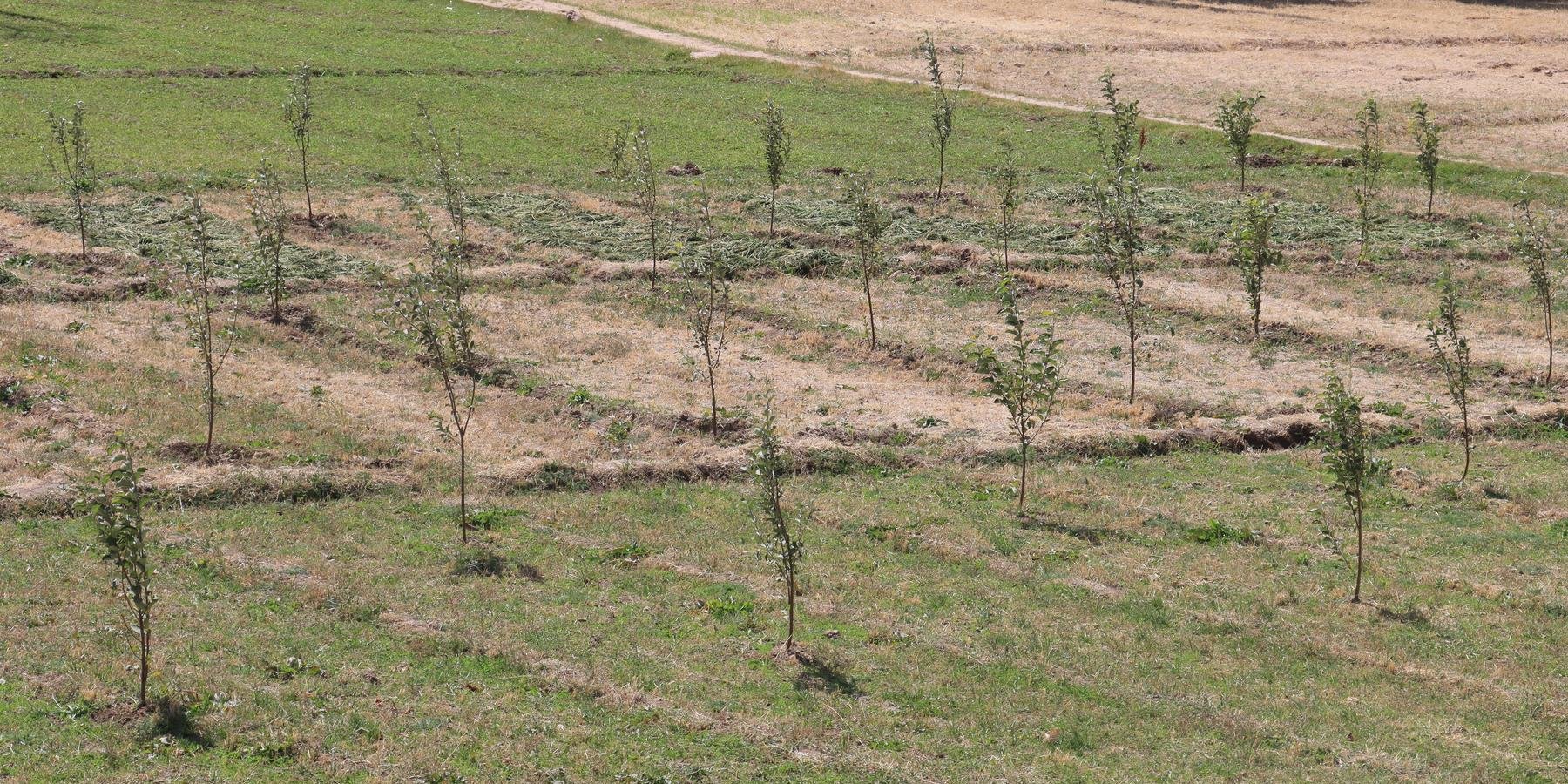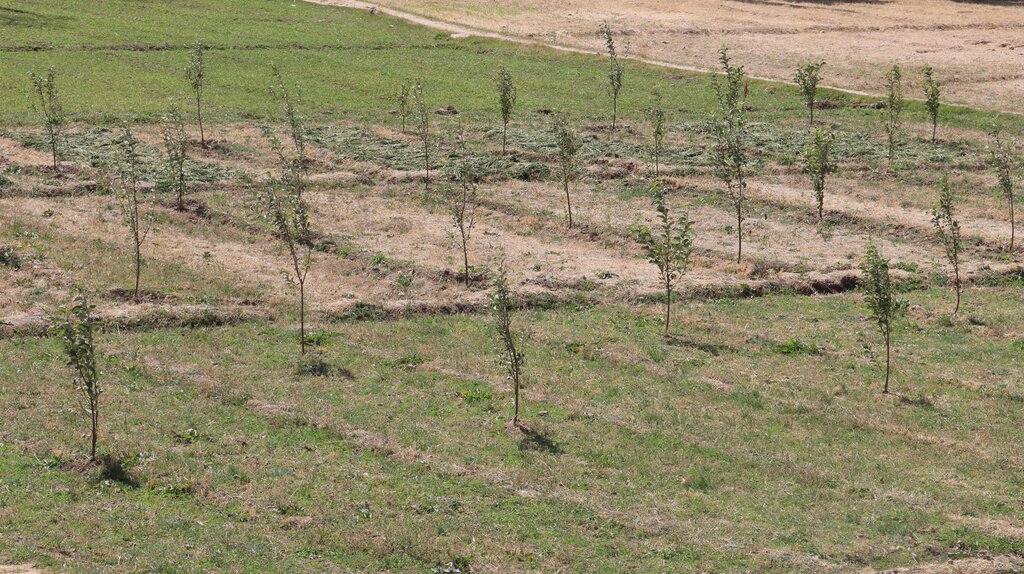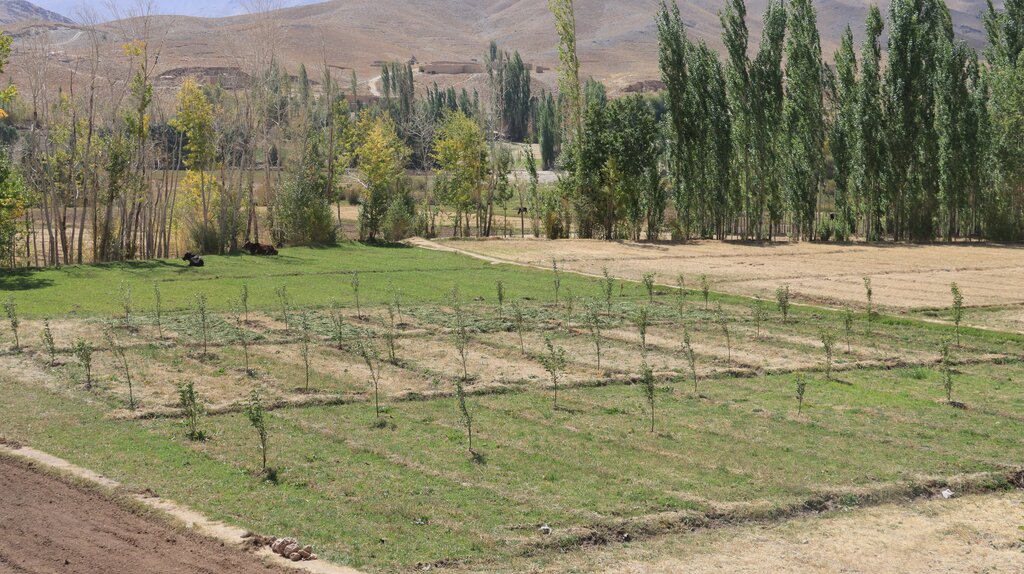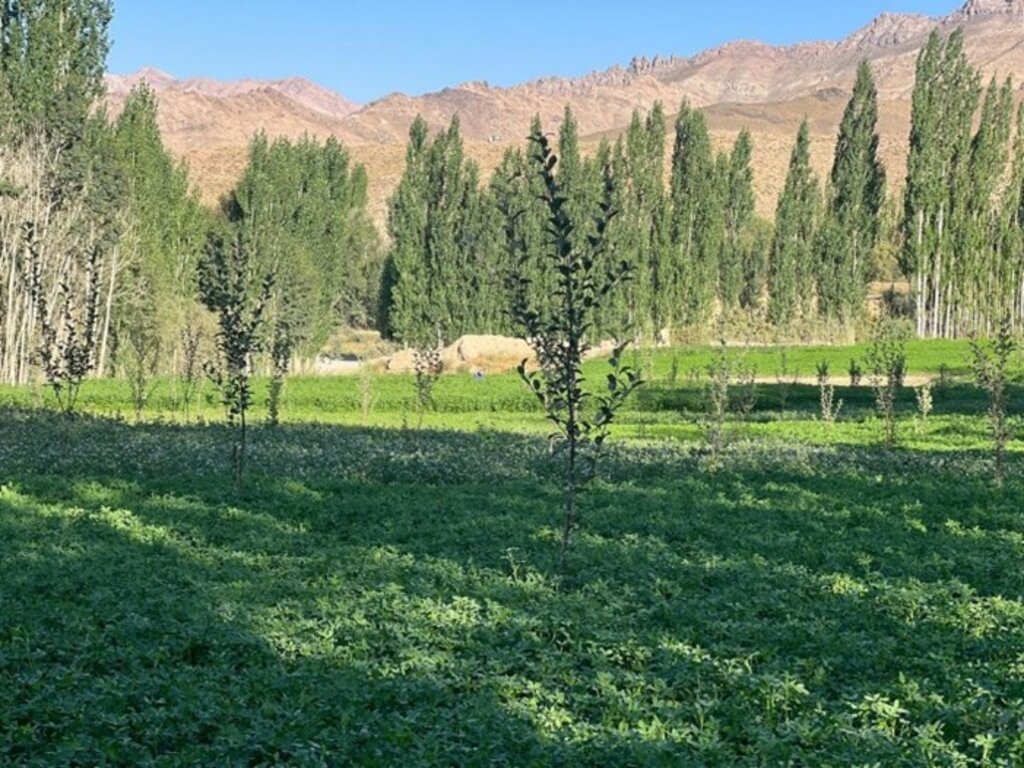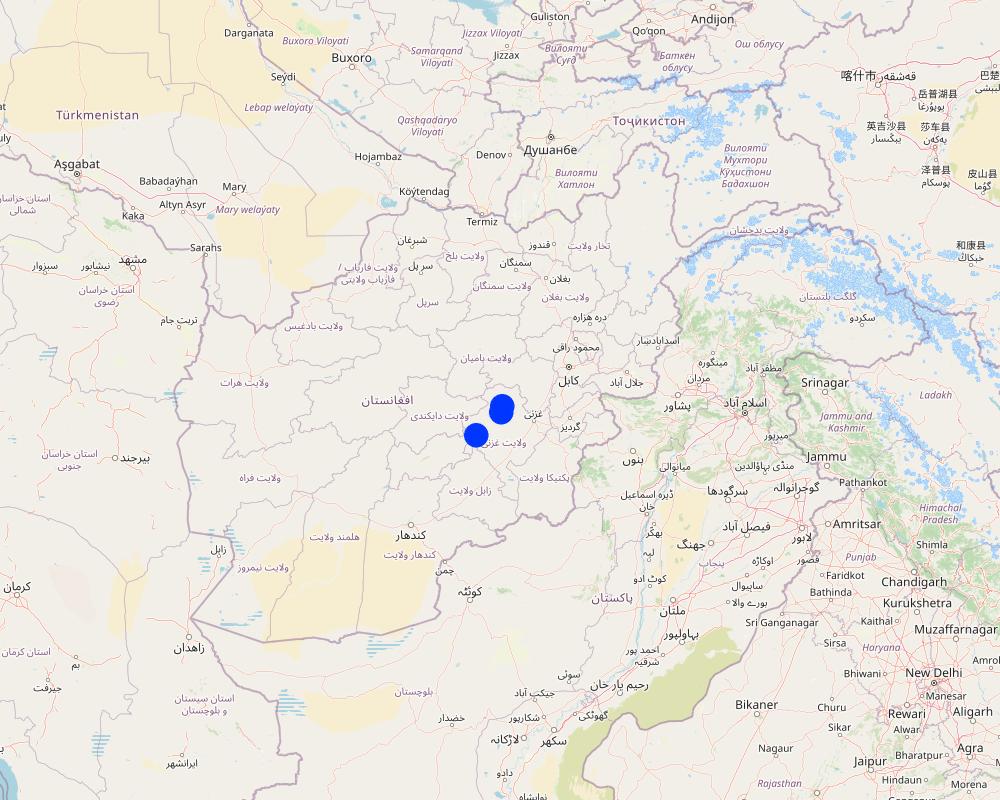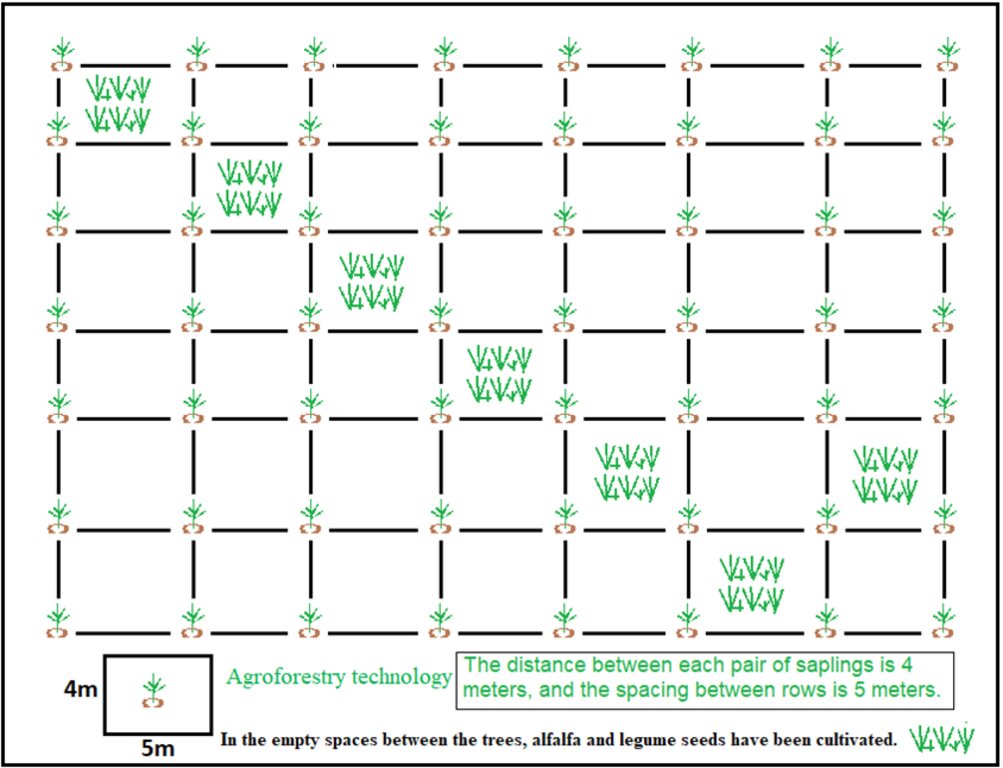Agroforestry to improve soil fertility, water retention, and sustainable income for local communities [Afghanistan]
- Creation:
- Update:
- Compiler: Ahmad Zia Jalalzai
- Editors: Mohammad Amin Nesar, Megha bajaj, Mir Wali Khan Lakanwal
- Reviewers: Rima Mekdaschi Studer, Illias Animon, Muhammad Ishaq Safi
د خاورې د خاصلخيزۍ ودې، اوبو ذخيره کولو او محلي ټولنو له پاره د دوامداره عايد په موخه د کرنيزې ځنګلدارۍ قطعو جوړول /ایجاد پلات زراعت جنگلی برای بهبود سلامت خاک، نگهداری آب و تأمین درآمد پایدار برای جوامع محلی
technologies_7443 - Afghanistan
View sections
Expand all Collapse all1. General information
1.2 Contact details of resource persons and institutions involved in the assessment and documentation of the Technology
SLM specialist:
SLM specialist:
Andar Ahmadullah
FAO Afghanistan
Afghanistan
land user:
Mohammad Haider
Ghaibi Rangeland Management Association (RMA)
Afghanistan
land user:
Ghullam Sakhi
Qarcha Rangeland Management Association (RMA)
Afghanistan
Name of project which facilitated the documentation/ evaluation of the Technology (if relevant)
Community-based sustainable land and forest management in AfghanistanName of the institution(s) which facilitated the documentation/ evaluation of the Technology (if relevant)
FAO Afghanistan (FAO Afghanistan) - Afghanistan1.3 Conditions regarding the use of data documented through WOCAT
The compiler and key resource person(s) accept the conditions regarding the use of data documented through WOCAT:
Yes
1.4 Declaration on sustainability of the described Technology
Is the Technology described here problematic with regard to land degradation, so that it cannot be declared a sustainable land management technology?
No
Comments:
This technology is applied with a focus on land restoration and conservation and is not problamatic with regard to land degradation.
2. Description of the SLM Technology
2.1 Short description of the Technology
Definition of the Technology:
The Agroforestry system in Malistan district combines traditional practices with support from the Community-Based Sustainable Land and Forest Management project in Afghanistan. This initiative provides technical support, training, and resources like apple trees, fertilizers, and alfalfa seeds to establish 400 orchards (1,000 m² each). The goal is to enhance community livelihoods by reducing dependence on rangelands, helping to preserve local ecosystems.
2.2 Detailed description of the Technology
Description:
The agroforestry system adopted in the mountainous districts of Ghazni province, particularly in Navor and Malistan district is an innovative approach that is transforming the way local farmers cultivate their land. This system integrates agricultural crops, tree cultivation, and livestock farming to maximize land productivity while promoting environmental sustainability. At the heart of the system are apple orchards, alfalfa seeds, and fertilizers, which work together to enhance food security, provide livestock feed, and improve soil fertility. Supported by modern agricultural techniques, the project includes a total of 400 orchards, each covering 1,000 square meters, helping to alleviate pressure on overgrazed rangelands while improving local livelihoods.
This agroforestry method is particularly well-suited to Ghazni’s rugged terrain, where farming communities rely heavily on livestock and rangelands for sustenance. However, the region’s dry climate, frequent overgrazing, and ongoing land degradation have made traditional farming increasingly unsustainable. By introducing apple trees and alfalfa cultivation, farmers now have an alternative source of income and animal feed while actively restoring degraded lands. Alfalfa serves as a nutrient-rich fodder for livestock, and in return, livestock manure is used as fertilizer, creating a self-sustaining agricultural cycle that enhances soil health.
Beyond its environmental benefits, this system plays a crucial role in improving livelihoods. By diversifying agricultural production, it enhances food security and generates additional income for local farmers. More importantly, it helps alleviate the burden on fragile rangelands by offering an alternative source of livestock feed, reducing overgrazing and preventing further land degradation. Through natural nutrient recycling, alfalfa provides essential fodder for livestock, while their manure replenishes soil nutrients, ensuring long-term soil fertility.
To successfully implement and maintain this system, several key activities and inputs are required. Local farmers receive specialized training and technical support to equip them with the necessary skills. Essential supplies, including apple saplings, fertilizers, and alfalfa seeds, are provided to help establish the orchards. Additionally, proper maintenance, such as irrigation, pruning, and weed control, ensures that the orchards remain productive. Soil and water conservation efforts, such as constructing contour banks and water diversion structures, further safeguard the land against erosion and water loss.
The impact of this technology extends far beyond the fields. Environmentally, it significantly reduces soil erosion, improves water retention, and restores soil health. Economically, it increases household income by boosting apple production and generating sales from alfalfa as livestock feed. Socially, it strengthens community resilience by offering a reliable source of food and income, while encouraging the adoption of sustainable farming practices.
While many farmers appreciate the system for its cost-effectiveness, sustainability, and diverse benefits, some challenges remain. Because of the duration for fruit production of apple trees are typically taking three to four years to bear fruit, patience and long-term planning is crucial. Additionally, the dry climate means that farmers must invest extra time and effort in irrigation, especially during drought periods, to ensure optimal growth and fruit yield. Despite these challenges, the agroforestry system in Malistan and Navor presents a promising solution for sustainable land management and rural development.
2.3 Photos of the Technology
2.4 Videos of the Technology
Comments, short description:
Artificial reseeding plays a vital role in the restoration of degraded rangeland ecosystems. Reseeding of local palatable fodder species in degraded rangeland is a restoration technique aimed at reintroducing native plants that support soil health and local biodiversity. This process enhances forage availability for grazing animals, stabilizes soil, and helps combat desertification by promoting sustainable vegetation cover. By using palatable, locally adapted species, artificial reseeding improves the health and productivity of degraded rangeland ecosystem.
Date:
20 october 2023
Location:
Malistan district Mokly village.
Name of videographer:
Ahmad Zia Jalalzai
2.5 Country/ region/ locations where the Technology has been applied and which are covered by this assessment
Country:
Afghanistan
Region/ State/ Province:
Southeastern Ghazni province
Further specification of location:
The technology is applied in 44 villages through 7 Rangeland Management Associations (RMAs). Hemat and Faqir are sample villages reflected in the map.
Specify the spread of the Technology:
- applied at specific points/ concentrated on a small area
Is/are the technology site(s) located in a permanently protected area?
No
Comments:
This project established 400 agroforestry plots (for 400 land users); the coordinates represent the samples locations for 400 orchards.
Map
×2.6 Date of implementation
Indicate year of implementation:
2022
2.7 Introduction of the Technology
Specify how the Technology was introduced:
- through projects/ external interventions
Comments (type of project, etc.):
The agroforestry system was introduced as an innovative, community-driven approach, offering an environmentally friendly alternative. This initiative was developed in response to the community's call for sustainable solutions that enhance livelihoods while preserving natural resources.
The agroforestry system integrates apple tree plantation with alfalfa intercropping, enhancing land productivity and sustainability by providing both fruit and forage. This technology improves livelihoods and promotes soil fertility and moisture retention for long-term environmental benefits
3. Classification of the SLM Technology
3.1 Main purpose(s) of the Technology
- improve production
- reduce, prevent, restore land degradation
- mitigate climate change and its impacts
- create beneficial economic impact
- create beneficial social impact
3.2 Current land use type(s) where the Technology is applied
Land use mixed within the same land unit:
Yes
Specify mixed land use (crops/ grazing/ trees):
- Agro-pastoralism (incl. integrated crop-livestock)

Cropland
- Perennial (non-woody) cropping
Perennial (non-woody) cropping - Specify crops:
- flower crops - perennial
Number of growing seasons per year:
- 2
Specify:
summer and fall season
Is intercropping practiced?
Yes
If yes, specify which crops are intercropped:
Alfaalfa is mainly used for intercropping
Is crop rotation practiced?
No

Grazing land
Intensive grazing/ fodder production:
- Cut-and-carry/ zero grazing
Animal type:
- cattle - dairy and beef (e.g. zebu)
Is integrated crop-livestock management practiced?
Yes
If yes, specify:
Animal manure is added in the fall season
Products and services:
- economic security, investment prestige
Species:
cattle - dairy and beef (e.g. zebu)
Count:
1345
Comments:
In autumn, people in the community graze their land with animals like cattle, sheep and goats. To manage and control the grazing, they use stakes and ropes to fence a specific area of land and ensure that the saplings are not damaged.
Planting of fruit trees helps to reduce pressure on rangeland grasses and shrubs to support landscape restoration.
Most land users plant apple trees and alfalfa. Some land users, who do not have animals, cultivate legumes instead of alfalfa.
3.3 Has land use changed due to the implementation of the Technology?
Has land use changed due to the implementation of the Technology?
- Yes (Please fill out the questions below with regard to the land use before implementation of the Technology)
Land use mixed within the same land unit:
Yes
Specify mixed land use (crops/ grazing/ trees):
- Agro-pastoralism (incl. integrated crop-livestock)

Cropland
- Perennial (non-woody) cropping
Perennial (non-woody) cropping - Specify crops:
- flower crops - perennial
Is intercropping practiced?
Yes
If yes, specify which crops are intercropped:
Earlier, wheat was planted only on the cropland and the only grazing land that was overgrazed and it became degraded. Now there is a mixed system agro-pastoralism in place due to the application of the technology.
Is crop rotation practiced?
No

Grazing land
Intensive grazing/ fodder production:
- Cut-and-carry/ zero grazing
Animal type:
- cattle - dairy and beef (e.g. zebu)
Is integrated crop-livestock management practiced?
No
Comments:
Most land users plant apple trees and alfalfa seeds. Some land users, who do not have animals, cultivate legume intercropping instead of alfalfa.
3.4 Water supply
Water supply for the land on which the Technology is applied:
- mixed rainfed-irrigated
Comments:
Out of the 400 agroforestry plots, some have full water availability, while others have 80% water availability. About 10% of the agroforestry plots receive only 40% to 60% of the required water. The saplings are mainly irrigated by spring rainfall. In a few plots, additional irrigation is provided two to three times during the warm season by transporting water from the canal using animals.
3.5 SLM group to which the Technology belongs
- pastoralism and grazing land management
- integrated crop-livestock management
- integrated soil fertility management
3.6 SLM measures comprising the Technology
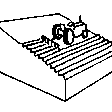
agronomic measures
- A2: Organic matter/ soil fertility
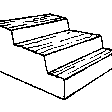
structural measures
- S2: Bunds, banks

management measures
- M6: Waste management (recycling, re-use or reduce)
Comments:
Residue management of trees is used for fuel, and alfalfa is utilized as livestock fodder in winter.
3.7 Main types of land degradation addressed by the Technology

soil erosion by water
- Wt: loss of topsoil/ surface erosion

soil erosion by wind
- Et: loss of topsoil

chemical soil deterioration
- Cn: fertility decline and reduced organic matter content (not caused by erosion)
- Ca: acidification
- Cp: soil pollution
- Cs: salinization/ alkalinization
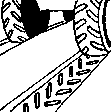
physical soil deterioration
- Pc: compaction
- Pk: slaking and crusting
- Pw: waterlogging
- Ps: subsidence of organic soils, settling of soil
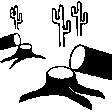
biological degradation
- Bc: reduction of vegetation cover
- Bh: loss of habitats
- Bq: quantity/ biomass decline
- Bs: quality and species composition/ diversity decline
- Bl: loss of soil life
- Bp: increase of pests/ diseases, loss of predators

water degradation
- Ha: aridification
- Hg: change in groundwater/aquifer level
- Hp: decline of surface water quality
- Hw: reduction of the buffering capacity of wetland areas
3.8 Prevention, reduction, or restoration of land degradation
Specify the goal of the Technology with regard to land degradation:
- reduce land degradation
- restore/ rehabilitate severely degraded land
Comments:
This project reduced the land degradation by applying this agroforestry technology.
4. Technical specifications, implementation activities, inputs, and costs
4.1 Technical drawing of the Technology
Technical specifications (related to technical drawing):
Saplings are planted in plotted areas with widths ranging from 4 to 5 meters. The outlines of the plots measure 40 × 50 meters, depending on the land structure. The spacing between saplings is 4 meters, with 5 meters between rows. Alfalfa and legume seeds are planted in the gaps. Small plots of 0.1 hectares were used, each containing 50 saplings.
Author:
Ahmad Zia Jalalzai
Date:
16/10/2024
4.2 General information regarding the calculation of inputs and costs
Specify how costs and inputs were calculated:
- per Technology area
Indicate size and area unit:
0.1 ha
Specify currency used for cost calculations:
- USD
Indicate average wage cost of hired labour per day:
5 USD
4.3 Establishment activities
| Activity | Timing (season) | |
|---|---|---|
| 1. | Survey and site selection follow by feasibility study | December to January |
| 2. | Procurement sapling and equipment | December and January |
| 3. | Levelling plots, cleaning from weeds | March |
| 4. | Designing layout | March |
| 5. | Digging planting pits | March |
| 6. | Planating apple saplings | spring |
| 7. | Irrigating | April to September |
| 8. | Training and pruning of orchard | October and Noverber |
4.4 Costs and inputs needed for establishment
| Specify input | Unit | Quantity | Costs per Unit | Total costs per input | % of costs borne by land users | |
|---|---|---|---|---|---|---|
| Labour | Labour for preparation of plots levelling, digging pits and cleaning weeds | Person/day | 10.0 | 5.0 | 50.0 | 100.0 |
| Labour | Labour for plantation | Person/day | 5.0 | 8.0 | 40.0 | 100.0 |
| Equipment | Shovel | Number | 1.0 | 4.0 | 4.0 | 100.0 |
| Equipment | Rope | Meter | 1.0 | 2.0 | 2.0 | 100.0 |
| Equipment | Hoe | Number | 1.0 | 3.0 | 3.0 | 100.0 |
| Equipment | Pruning scissors | Number | 1.0 | 10.0 | 10.0 | 100.0 |
| Equipment | Wheelbarrow | Number | 1.0 | 1.0 | 1.0 | 100.0 |
| Plant material | Alfalfa seeds | Kg | 4.0 | 3.0 | 12.0 | |
| Plant material | Apple sapling | Number | 50.0 | 1.0 | 50.0 | |
| Fertilizers and biocides | DAP | Kg | 25.0 | 3.0 | 75.0 | |
| Fertilizers and biocides | Urea | Kg | 25.0 | 1.0 | 25.0 | |
| Total costs for establishment of the Technology | 272.0 | |||||
| Total costs for establishment of the Technology in USD | 272.0 | |||||
4.5 Maintenance/ recurrent activities
| Activity | Timing/ frequency | |
|---|---|---|
| 1. | Applying manure for growth of crops and trees(refers to using organic animal waste (such as cow, horse, chicken, or sheep manure) to improve soil fertility and promote plant growth.) | in fall season |
| 2. | Disc ploughing and harrowing | in fall season |
| 3. | Chemical fertilizer application to crops | at the time of observing needs |
| 4. | Pest management with chemicals | in spring season |
| 5. | Irrigation of sapling | As per needed time |
| 6. | Mulching trees (humus cover)refers to the practice of covering the soil around trees with organic material, such as humus, straw, leaves, wood chips, or compost. | In a hot summer and lack of water, dry year |
| 7. | Pruning trees | in spring season |
| 8. | Operation and maintenance | spring, summer and fall |
Comments:
Inputs needed for maintenance/ recurrent activities (per year)
4.6 Costs and inputs needed for maintenance/ recurrent activities (per year)
| Specify input | Unit | Quantity | Costs per Unit | Total costs per input | % of costs borne by land users | |
|---|---|---|---|---|---|---|
| Labour | Unskilled labour | Person/day | 20.0 | 5.0 | 100.0 | 100.0 |
| Labour | ploughing | person/day | 2.0 | 5.0 | 10.0 | |
| Labour | apply of fertilizer and manure | person/day | 2.0 | 5.0 | 10.0 | |
| Labour | form pest management | person/day | 3.0 | 5.0 | 15.0 | |
| Labour | planting of annual crops / perennial alfalfa | person/day | 2.0 | 5.0 | 10.0 | |
| Labour | Uprooting dry sapling and replacing to fresh sapling. | Number | 2.0 | 1.0 | 2.0 | 100.0 |
| Equipment | Shovel | Number | 1.0 | 3.0 | 3.0 | 100.0 |
| Fertilizers and biocides | Organic fertilizer | M3 | 1.0 | 10.0 | 10.0 | 100.0 |
| Fertilizers and biocides | DAP | |||||
| Fertilizers and biocides | Urea | |||||
| Fertilizers and biocides | Pesticides | |||||
| Total costs for maintenance of the Technology | 160.0 | |||||
| Total costs for maintenance of the Technology in USD | 160.0 | |||||
Comments:
After establishment, all responsibilities for maintenance, operations activity, care, and management belongs to land users.
4.7 Most important factors affecting the costs
Describe the most determinate factors affecting the costs:
Usually, the land users are farmers, and all the activities are performed by the land users. The project team provides technical support and capacity building. The most important factors affecting the cost in the project are the materials’ accessibility in the field such as saplings, chemical fertilizer, and pesticides.
5. Natural and human environment
5.1 Climate
Annual rainfall
- < 250 mm
- 251-500 mm
- 501-750 mm
- 751-1,000 mm
- 1,001-1,500 mm
- 1,501-2,000 mm
- 2,001-3,000 mm
- 3,001-4,000 mm
- > 4,000 mm
Agro-climatic zone
- semi-arid
5.2 Topography
Slopes on average:
- flat (0-2%)
- gentle (3-5%)
- moderate (6-10%)
- rolling (11-15%)
- hilly (16-30%)
- steep (31-60%)
- very steep (>60%)
Landforms:
- plateau/plains
- ridges
- mountain slopes
- hill slopes
- footslopes
- valley floors
Altitudinal zone:
- 0-100 m a.s.l.
- 101-500 m a.s.l.
- 501-1,000 m a.s.l.
- 1,001-1,500 m a.s.l.
- 1,501-2,000 m a.s.l.
- 2,001-2,500 m a.s.l.
- 2,501-3,000 m a.s.l.
- 3,001-4,000 m a.s.l.
- > 4,000 m a.s.l.
Comments and further specifications on topography:
As the technology have been applied in a 400 different topography plots, some of the plots are in a flatted, gentle and hilly slop and most of the technologies are applied in flatted area.
5.3 Soils
Soil depth on average:
- very shallow (0-20 cm)
- shallow (21-50 cm)
- moderately deep (51-80 cm)
- deep (81-120 cm)
- very deep (> 120 cm)
Soil texture (topsoil):
- medium (loamy, silty)
Soil texture (> 20 cm below surface):
- medium (loamy, silty)
Topsoil organic matter:
- medium (1-3%)
If available, attach full soil description or specify the available information, e.g. soil type, soil PH/ acidity, Cation Exchange Capacity, nitrogen, salinity etc.
In Ghazni province, the primary soil types include Aridisols in arid regions, Entisols on slopes, Sierozems in desert areas, and fertile Alluvial soils in valleys that support agriculture. Soil pH levels in the region range from 6.33 (slightly acidic) to 8.52 (alkaline), indicating varying degrees of acidity and alkalinity. The Cation Exchange Capacity (CEC), nitrogen levels, and salinity vary across these soil types, influencing agricultural productivity and land management practices. For more detailed information, including specific nutrient content and soil characteristics, resources such as the FAO’s Agro-Climatic Atlas can be consulted.
5.4 Water availability and quality
Ground water table:
5-50 m
Availability of surface water:
excess
Water quality (untreated):
good drinking water
Water quality refers to:
both ground and surface water
Is water salinity a problem?
No
Is flooding of the area occurring?
Yes
Regularity:
episodically
Comments and further specifications on water quality and quantity:
In years with heavy snowfall, water availability increases, and springs are replenished. Conversely, during drought years, water resources decrease significantly. From July to September, a water shortage is commonly experienced, prompting farmers to transport water from canals using animals. Additionally, some farmers rely on groundwater specifically for irrigating saplings. This seasonal variation in water supply is critical for agricultural practices in the province.
5.5 Biodiversity
Species diversity:
- medium
Habitat diversity:
- medium
5.6 Characteristics of land users applying the Technology
Sedentary or nomadic:
- Sedentary
Market orientation of production system:
- mixed (subsistence/ commercial)
Off-farm income:
- 10-50% of all income
Relative level of wealth:
- very poor
- poor
Individuals or groups:
- individual/ household
Level of mechanization:
- manual work
Gender:
- women
- men
Age of land users:
- middle-aged
- elderly
5.7 Average area of land used by land users applying the Technology
- < 0.5 ha
- 0.5-1 ha
- 1-2 ha
- 2-5 ha
- 5-15 ha
- 15-50 ha
- 50-100 ha
- 100-500 ha
- 500-1,000 ha
- 1,000-10,000 ha
- > 10,000 ha
Is this considered small-, medium- or large-scale (referring to local context)?
- medium-scale
Comments:
Everyone individually has possessed land ranging from 0.5 hectares to 2 hectares in communities. However, land users has allocated only 0.1 hectares of land for the application of this technology.
5.8 Land ownership, land use rights, and water use rights
Land ownership:
- communal/ village
- individual, titled
Land use rights:
- communal (organized)
- individual
Water use rights:
- open access (unorganized)
- communal (organized)
Are land use rights based on a traditional legal system?
Yes
Specify:
The traditional system refers to a record that recognizes land ownership and is issued based on the customs and traditions of local communities. This document is not legal but is used within the community to validate ownership.
Comments:
The land in this area is privately owned, while the rangeland is government-owned and accessible for public use. However, some individuals have encroached the rangeland, converting it into agricultural land and claiming it as their own property, despite lacking legal ownership documentation.
5.9 Access to services and infrastructure
health:
- poor
- moderate
- good
education:
- poor
- moderate
- good
technical assistance:
- poor
- moderate
- good
employment (e.g. off-farm):
- poor
- moderate
- good
markets:
- poor
- moderate
- good
energy:
- poor
- moderate
- good
roads and transport:
- poor
- moderate
- good
drinking water and sanitation:
- poor
- moderate
- good
financial services:
- poor
- moderate
- good
6. Impacts and concluding statements
6.1 On-site impacts the Technology has shown
Socio-economic impacts
Production
crop production
Quantity before SLM:
0
Quantity after SLM:
Now we have 400 apple orchards
Comments/ specify:
In the past, there were no apple orchard in this area. The community mostly relied on the rangeland, and the animal feed was limited then. Due to the application of these technologies, the apple orchard has increased, and alfalfa intercrops have been expanded for animal feeding. As a result, pressure on the rangeland has decreased.
crop quality
Quantity before SLM:
less then 10 orchard. No alfaalf crops
Quantity after SLM:
400 orchards with Alfaalfa crops
Comments/ specify:
Alfalfa intercrops have become friendly feeds for animals, along with other grasses harvested from the rangeland.
fodder production
Quantity before SLM:
less then 10 plots of Alfaalfa
Quantity after SLM:
400 plots
fodder quality
Comments/ specify:
Crops production specifically grown to feed livestock. It plays a crucial role in ensuring a steady supply of nutritious feed for animals, especially in dairy and meat production systems.
animal production
Water availability and quality
water availability for livestock
water quality for livestock
irrigation water availability
Income and costs
farm income
Quantity before SLM:
It is not distinguishable for now
Quantity after SLM:
It is not distinguishable for now
Comments/ specify:
The cultivation of apple orchards and alfalfa crops has significant environmental, economic, and agricultural benefits. When grown together in an agroforestry system, they create a sustainable and productive farming model.
Other socio-economic impacts
The cultivation of apple orchards and alfalfa crops has significant environmental, economic, and agricultural benefits. When grown together in an agroforestry system, they create a sustainable and productive farming model.
Quantity before SLM:
It is not distinguishable for now
Quantity after SLM:
It is not distinguishable for now
Comments/ specify:
The cultivation of apple orchards and alfalfa crops has significant social benefits, contributing to rural development, employment, food security, and community well-being.
Socio-cultural impacts
food security/ self-sufficiency
Quantity before SLM:
less then 10 orchard
Quantity after SLM:
400
Comments/ specify:
Food security is achieved when people have consistent access to sufficient, safe, and nutritious food to maintain a healthy life. The cultivation of apple orchards and alfalfa crops plays a crucial role in enhancing food security by ensuring the availability of fruits, livestock feed, and sustainable agricultural income.
health situation
Quantity before SLM:
less then 10 orchard
Quantity after SLM:
400 orchard
Comments/ specify:
The cultivation of apple orchards and alfalfa crops has a direct and indirect impact on human and animal health. These crops provide essential nutrients, improve environmental conditions, and contribute to sustainable food systems that enhance overall well-being.
recreational opportunities
Quantity before SLM:
less then 10 orchard
Quantity after SLM:
400
Comments/ specify:
The cultivation of apple orchards and alfalfa crops not only provides food and economic benefits but also creates various recreational opportunities. These activities promote tourism, community engagement, and overall well-being, contributing to rural development and environmental appreciation.
SLM/ land degradation knowledge
Comments/ specify:
The cultivation of apple orchards and alfalfa crops plays a significant role in Sustainable Land Management (SLM) by improving soil health, preventing degradation, and enhancing ecosystem services. Properly managed apple orchards and alfalfa fields help restore land fertility, prevent erosion, and support long-term agricultural sustainability.
Ecological impacts
Soil
soil moisture
Comments/ specify:
The cultivation of apple orchards and alfalfa crops has significant effects on soil moisture due to their respective water demands, root systems, and overall impact on the surrounding ecosystem. Both crops, when properly managed, can help retain moisture in the soil and improve its structure, but if mismanaged, they can also lead to issues like water depletion or soil erosion.
soil cover
Comments/ specify:
The cultivation of apple orchards and alfalfa crops can have significant effects on soil cover, which plays a crucial role in protecting the soil from erosion, enhancing water retention, and promoting overall soil health. Proper management of soil cover is essential for ensuring sustainable agricultural practices and maintaining soil fertility over time.
soil organic matter/ below ground C
Comments/ specify:
The cultivation of apple orchards and alfalfa crops plays a significant role in the accumulation and dynamics of soil organic matter (SOM) and below-ground carbon (C). Both of these components are essential for soil fertility, carbon sequestration, and overall ecosystem health. The management of these factors has critical implications for sustainable farming practices, climate change mitigation, and long-term soil productivity.
Biodiversity: vegetation, animals
beneficial species
Climate and disaster risk reduction
flood impacts
Comments/ specify:
Floods are one of the most significant climate-related risks that can affect agricultural systems, particularly in regions prone to heavy rainfall or where irrigation infrastructure is inadequate. Both apple orchards and alfalfa crops are vulnerable to flood impacts, which can result in loss of yield, soil degradation, and cause damage to the overall ecosystem. However, with effective disaster risk reduction strategies, the negative impacts of floods on these crops can be mitigated.
drought impacts
Comments/ specify:
apple orchards and alfalfa crops are highly sensitive to water stress, and prolonged drought conditions can reduce crop yields, degrade soil quality, and negatively affect the overall health of these plants. Understanding the impacts of drought on these crops and implementing appropriate water management strategies are crucial for maintaining agricultural productivity in drought-prone areas.
6.2 Off-site impacts the Technology has shown
water availability
Comments/ specify:
The cultivation of apple orchards and alfalfa crops, especially when enhanced by technology, can have significant off-site impacts on water availability. These impacts stem from how irrigation systems, water management practices, and agricultural technologies influence local and regional water resources, hydrology, and ecosystems. Off-site effects include changes to water quality, water use efficiency, and the sustainability of water resources in surrounding areas.
6.3 Exposure and sensitivity of the Technology to gradual climate change and climate-related extremes/ disasters (as perceived by land users)
Comments:
The cultivation of apple orchards and alfalfa crops is highly sensitive to both gradual climate change and climate-related extremes like floods, droughts, and temperature fluctuations. These climate impacts affect not only the crops' growth and yield but also the technologies used in managing these crops. Understanding the exposure and sensitivity of these agricultural technologies to such climate factors is crucial for farmers and land users to ensure long-term sustainability.
6.4 Cost-benefit analysis
How do the benefits compare with the establishment costs (from land users’ perspective)?
Short-term returns:
neutral/ balanced
Long-term returns:
very positive
How do the benefits compare with the maintenance/ recurrent costs (from land users' perspective)?
Short-term returns:
neutral/ balanced
Long-term returns:
positive
Comments:
Before the project was implemented, the land was either used for wheat cultivation or left fallow. With the introduction of the agroforestry project, tree seedlings were planted, and alfalfa was grown. In some plots, legumes were cultivated instead of alfalfa. In the first year, the production of alfalfa and legumes significantly outpaced the wheat yield, resulting in high levels of satisfaction and happiness among the local communities.
6.5 Adoption of the Technology
- 1-10%
Of all those who have adopted the Technology, how many did so spontaneously, i.e. without receiving any material incentives/ payments?
- 11-50%
Comments:
In addition to the 400 gardens established through the project, local communities independently created 50 small and large gardens without any financial assistance. They purchased saplings from the market and, having previously received capacity-building training from the project team, applied agroforestry practices on plots of various sizes, tailored to their available land.
6.6 Adaptation
Has the Technology been modified recently to adapt to changing conditions?
No
6.7 Strengths/ advantages/ opportunities of the Technology
| Strengths/ advantages/ opportunities in the land user’s view |
|---|
| Integrated systems that combine apple trees with alfalfa and legumes offer several benefits. Farmers appreciated the enhanced biodiversity, which supports pest control and improves pollination, leading to healthier crops and increased yields. The intercropping of legumes is particularly valued for its role in improving soil fertility through nitrogen fixation, reducing dependence on synthetic fertilizers, and promoting sustainable farming practices. |
| Economically, farmers find that this system provides diversified income sources, as they can sell both fruit and forage crops, which mitigates risks associated with crop failure. Additionally, the ability to optimize land use while maintaining ecological balance is a significant advantage. This resource efficiency, coupled with the adaptability of practices to different climates and soils, enables farmers to achieve resilience against climate variability. |
| Furthermore, land users recognize the opportunities for community engagement and knowledge sharing to promotes agroforestry. As these systems gain popularity, farmers are increasingly accessing markets for sustainably produced goods, enhancing their profitability. With supportive policies of sustainable land management, the future of agroforestry initiatives appears promising, benefiting both the environment and local economies. |
| Strengths/ advantages/ opportunities in the compiler’s or other key resource person’s view |
|---|
| Integrated systems of apple trees intercropped with alfalfa and legumes are recognized for their multifaceted benefits. They highlight the importance of these systems in promoting sustainable agricultural practices, noting that the biodiversity fostered by agroforestry enhances pest control and supports healthier ecosystems. This ecological balance is crucial not only for soil health but also for mitigating the reliance on chemical inputs, which aligns with global sustainability goals (Nair, 2019; FAO, 2020). |
| Moreover, compilers emphasize the economic advantages of agroforestry. By diversifying income streams, these systems reduce financial risks for farmers and stabilize local economies. The adaptability of agroforestry practices to various climates and soil types allows for broader implementation, making it an attractive option for diverse agricultural settings (Schroth et al., 2004; Somarriba et al., 2016). |
| Key resource persons also note the social dimension of agroforestry, as these systems encourage community engagement and collaboration. This participatory technology fosters knowledge sharing, leading to improved agricultural practices and strengthening local capacities. With increasing support from policies advocating for sustainable land management, agroforestry initiatives are well-positioned for growth and development, contributing to both environmental health and economic resilience (Pretty, 2018; Wang et al., 2020). |
6.8 Weaknesses/ disadvantages/ risks of the Technology and ways of overcoming them
| Weaknesses/ disadvantages/ risks in the land user’s view | How can they be overcome? |
|---|---|
| Initial costs and investment risks | The project team provided seedlings, fertilizers, and Alfalfa seeds at the start of the technology. Land users were responsible for carrying out physical activities such as digging holes, planting seedlings, and irrigation, which helps reduce costs and fosters a sense of ownership among the participants. |
| Low knowledge of the technology and skill gaps | To address educational gaps, the project’s field team conducted capacity-building programs and workshops before implementing the technology. This initiative has enabled land users to become familiar with new methods and enhance their capabilities in agroforestry |
| Market access and economic viability | The project team established agroforestry committees and facilitated direct market communication and improved access for land users to sell their produce. It has provided sales skills training to land users, allowing them to make more profit from their produce |
| 4) Pest and disease management: | 4) The project's field team has educated land users about common pests and diseases in the area and provided them with preventive management strategies. In case of new issues, they have been linked with the Department of Agriculture to ensure timely and effective support. |
| Weaknesses/ disadvantages/ risks in the compiler’s or other key resource person’s view | How can they be overcome? |
|---|---|
| Provision of Resources and Local Engagement: | Importance of equipping land users with essential materials, such as sapling and fertilizers, to lower initial barriers and encourage participation. Enhance ownership to ensure sustainability when the project pulls out |
| Addressing educational gaps | Realizing that knowledge gaps could hinder the project’s success, the team implemented pre-launch training workshops. These sessions were aimed at familiarizing land users with innovative agroforestry, helping to ensure their understanding and effective implementation of new techniques. |
| Market connections and economic benefits | Key resource personnel highlighted the importance of establishing market access for sustainable success. By Rangeland management Association and offering training in market engagement, the project helped land users gain market literacy, empowering them to maximize income potential from their produce. |
| Support for pest and disease management | The project team prioritized proactive pest and disease management by training land users in common pest prevention techniques. The creation of a support network with the Department of Agriculture ensures that land users have access to timely guidance for any emerging issues, ensuring resilience and adaptability in their practices. |
7. References and links
7.1 Methods/ sources of information
- field visits, field surveys
Field visits and field surveys by project team
- interviews with land users
About one per agroforestry plot by project team
- interviews with SLM specialists/ experts
Three people - project implementation unit.
- compilation from reports and other existing documentation
Field reports and documents.
When were the data compiled (in the field)?
16/12/2024
Links and modules
Expand all Collapse allLinks
No links
Modules
No modules


